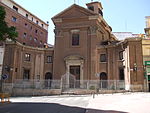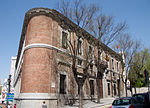Monument to Miguel de Cervantes
AC with 0 elementsBuildings and structures in Argüelles neighborhood, MadridEquestrian statues in MadridMonuments and memorials in MadridOutdoor sculptures in Madrid ... and 5 more
Sculptures of men in SpainSculptures of women in SpainStatues of Miguel de CervantesWorks based on Don QuixoteWorks based on La gitanilla

The Monument to Miguel de Cervantes is an instance of public art located in Madrid, Spain. Erected on the centre of the Plaza de España, it is dedicated to Miguel de Cervantes, widely regarded as the greatest writer in the Spanish language. The monument incorporates a stone monolith with several statues (including Cervantes') and a detached bronze sculptural group representing Don Quixote and Sancho Panza.
Excerpt from the Wikipedia article Monument to Miguel de Cervantes (License: CC BY-SA 3.0, Authors, Images).Monument to Miguel de Cervantes
Plaza de España, Madrid
Geographical coordinates (GPS) Address External links Nearby Places Show on map
Geographical coordinates (GPS)
| Latitude | Longitude |
|---|---|
| N 40.423201 ° | E -3.712583 ° |
Address
Monumento a Cervantes
Plaza de España
28008 Madrid (Moncloa-Aravaca)
Community of Madrid, Spain
Open on Google Maps











